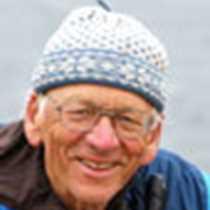Off Archipelago Abrolhos, Brasil
Got Humpbacks! Got Fish? Got Brasil!
The soft light of an overcast morning with gentle seas greeted our first day at sea off the central coast of Brasil. Searching the waves for any signs of marine mammals was the first order of the day. Soon after breakfast, the first call went through the ship to come out on deck. Off the port side was a lone Humpback Whale rolling along with the waves and low swell. Our location was immediately east of the eastern most part of the shallow coral reef area called Abrolhos by the locals. This area is known as one of a few spots around the world where Humpback Whales congregate during the appropriate hemisphere's summer period. The animals are in these warm water areas for breeding activities and also to give birth to their young. Relatively warm waters give the young whales, which have little insulation and fat when born, time to nurse on the fat-rich milk of its mother. Then after a couple of months of growing and "fattening up," they start the long migration south to the cold but rich waters around Antarctica.
"Got Fish?" was the title of a talk by Jim Kelley. We are traveling through the western Atlantic Ocean. During the voyage, we cross a number of different ocean currents, such as the southward flowing Brazilian Current. These currents combined with bottom contours and other oceanographic factors contribute to the productivity of the waters. The amount of productivity then translates into the abundance of fish and other animals that feed on fish such as bigger fish, birds, and marine mammals.
Throughout the day, we spotted Humpback Whales in various behaviors. The photo is of our first individual of the day. Scientists discovered a couple decades ago that Humpback Whales have individual and distinct patterns of black and white on the underside of their tail. This pattern can be photographed when the whale dives then put into a "catalog" so researchers can essentially follow the movements and life of individual animals. If at some time an animal is seen with a calf, it becomes an animal of known sex. Today the animal was by itself slowly swimming southward off the coast of Brasil.
Speaking of this huge and diverse country, Susana Machado D'Oliviera gave a quick but thorough and quite informative talk on the history of Brasil. She set the stage for the next few days when we have an opportunity to experience some of the flavor, sights, and sounds of this country. Then as the light faded, we spotted more Humpback Whales as a finale to a relaxing but busy day at sea.
Got Humpbacks! Got Fish? Got Brasil!
The soft light of an overcast morning with gentle seas greeted our first day at sea off the central coast of Brasil. Searching the waves for any signs of marine mammals was the first order of the day. Soon after breakfast, the first call went through the ship to come out on deck. Off the port side was a lone Humpback Whale rolling along with the waves and low swell. Our location was immediately east of the eastern most part of the shallow coral reef area called Abrolhos by the locals. This area is known as one of a few spots around the world where Humpback Whales congregate during the appropriate hemisphere's summer period. The animals are in these warm water areas for breeding activities and also to give birth to their young. Relatively warm waters give the young whales, which have little insulation and fat when born, time to nurse on the fat-rich milk of its mother. Then after a couple of months of growing and "fattening up," they start the long migration south to the cold but rich waters around Antarctica.
"Got Fish?" was the title of a talk by Jim Kelley. We are traveling through the western Atlantic Ocean. During the voyage, we cross a number of different ocean currents, such as the southward flowing Brazilian Current. These currents combined with bottom contours and other oceanographic factors contribute to the productivity of the waters. The amount of productivity then translates into the abundance of fish and other animals that feed on fish such as bigger fish, birds, and marine mammals.
Throughout the day, we spotted Humpback Whales in various behaviors. The photo is of our first individual of the day. Scientists discovered a couple decades ago that Humpback Whales have individual and distinct patterns of black and white on the underside of their tail. This pattern can be photographed when the whale dives then put into a "catalog" so researchers can essentially follow the movements and life of individual animals. If at some time an animal is seen with a calf, it becomes an animal of known sex. Today the animal was by itself slowly swimming southward off the coast of Brasil.
Speaking of this huge and diverse country, Susana Machado D'Oliviera gave a quick but thorough and quite informative talk on the history of Brasil. She set the stage for the next few days when we have an opportunity to experience some of the flavor, sights, and sounds of this country. Then as the light faded, we spotted more Humpback Whales as a finale to a relaxing but busy day at sea.




